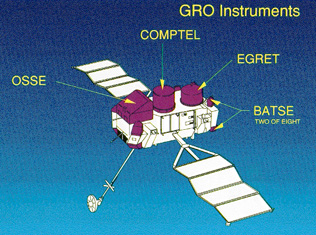The Compton Gamma Ray Observatory Mission

The Compton Gamma Ray Observatory was the second of NASA's Great
Observatories following the Hubble Space Telescope. It was launched from the space shuttle Atlantis
on April 5, 1991. Its large weight and low-earth orbit necessitated
a number of orbit reboosts throughout its lifetime, which were all
accomplished successfully. The observatory was named after Arthur
Holly Compton, who won the Nobel prize in physics for work on
scattering of high energy
photons by
electrons.
Three of the four of the CGRO instruments use this principle to detect
gamma-rays.

Instrumentation
Compton had four instruments which covered the high energy
electromagnetic spectrum from 30 keV to 30 GeV: BATSE, OSSE, COMPTEL,
and EGRET.
The Burst And Transient Source Experiment (BATSE) detected and
located transient sources such as gamma ray bursts and outbursts
from other sources (including solar flares from the sun) all
over the sky. Eight BATSE detectors, one facing outward from
each corner of CGRO, together view the entire sky from 20 keV
to 1000 keV. BATSE detects gamma rays using NaI crystals,
which flash in visible light when struck by gamma rays.
The Oriented Scintillation Spectrometer Experiment (OSSE)
measured the distribution of the energy emitted from a number
of gamma-ray sources, and as such studied nuclear lines in
solar flares, radioactive decay of nuclei in supernova remnants,
and matter-antimatter annihilation taking place near the center
of our galaxy. OSSE consisted of four NaI scintillation crystals,
and was sensitive to gamma rays with energies ranging from
50 keV to 10 Mev. Each of the detectors could be pointed
individually. For most instances, observations of a gamma
ray source were alternated with observations of nearby blank
sky so as to be able to determine the background gamma ray
emission.
The Imaging Compton Telescope (COMPTEL) constructed images
of gamma ray sources, which was useful in the study of active
galaxies, supernova remnants, and diffuse gamma ray emission
from giant molecular clouds. COMPTEL used two layers of gamma
ray detectors to study gamma rays ranging from 1 to 30 MeV. The
top layer is filled with a liquid scintillator which scatters
a gamma ray photon and lowers its energy. The scattered photon
is absorbed in the lower layer, and the direction and energy
of the original gamma ray photon is determined.
The Energetic Gamma Ray Experiment Telescope (EGRET) detected
the highest energy gamma-rays of all the instruments on CGRO -
20 MeV to 30 GeV. Its sensitivity allowed for studies of
diffuse gamma ray emission, gamma ray bursts, cosmic rays,
pulsars, and blazars. The EGRET instrument produced images
using high voltage, gas-filled spark chambers. Gamma rays
entering the chamber produced pairs of electrons and positrons.
The path of the pairs and their energies were recorded, allowing
scientists to determine the direction and energy of the original
incoming gamma ray. From this, an image of the source could
be constructed.
| BATSE | OSSE | COMPTEL | EGRET |
|---|
| Developer |
NASA/Marshall
| Naval Research Lab
| Univ. N.H. & MPE
| NASA/Goddard |
|---|
| Energy Range (MeV) |
0.03 to 1.9
| 0.05 to 10.0
| 0.08 to 30.0
| 30.0 to 30000.0 |
|---|
| Field of View |
entire sky
| 3.0 x 11.4 degrees
| 64 degrees
| 0.6 steradians |
|---|
| Spectral Resolution (FWHM) |
32 % at 0.06 MeV
27 % at 0.09 MeV
20 % at
0.66 MeV
| 12.5 % at 0.2 MeV
5. % at 1.0 MeV
4.0 %
at 5.0 MeV
| 8.8 % at 1.27 MeV
6.5 % at 2.75 MeV
6.3 %
at 4.43 MeV
| 20 % |
|---|
| Effective Area (cm2) |
1000 ea. at 0.03 MeV
1800 ea. at 0.1
MeV
550 ea. at 0.55 MeV
| 2013 at 0.2 MeV
1400 at 1.0 MeV
55 at 5.0
MeV
| 25.0 at 1.27 MeV
29.3 at 2.75 MeV
29.4 at
4.43 MeV
| 1200 at 100 Mev
1600 at 500 MeV
1400 at
3000 MeV |
|---|
Spatial Resolution
(for strong sources) |
3 degrees
| 10 x 10 arcminutes
| 0.5 - 1.0 degrees
| 5 - 10 arcminutes |
|---|
Information on this page adapted from the
CGRO Web Site (http://cossc.gsfc.nasa.gov)
Additional Links
 CGRO Web Site (http://cossc.gsfc.nasa.gov/) CGRO Web Site (http://cossc.gsfc.nasa.gov/)
|
